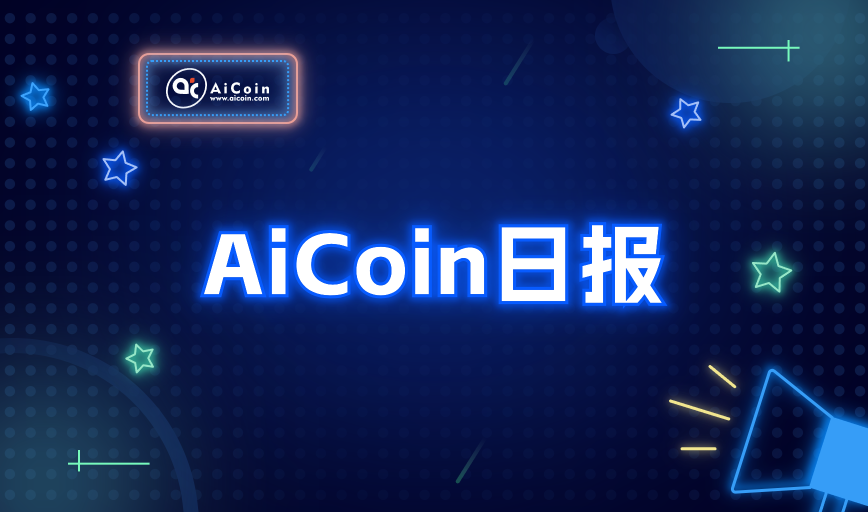Author | @blocmates
Compiled by | Odaily Planet Daily (@OdailyChina)
Translator | Dingdang (@XiaMiPP)
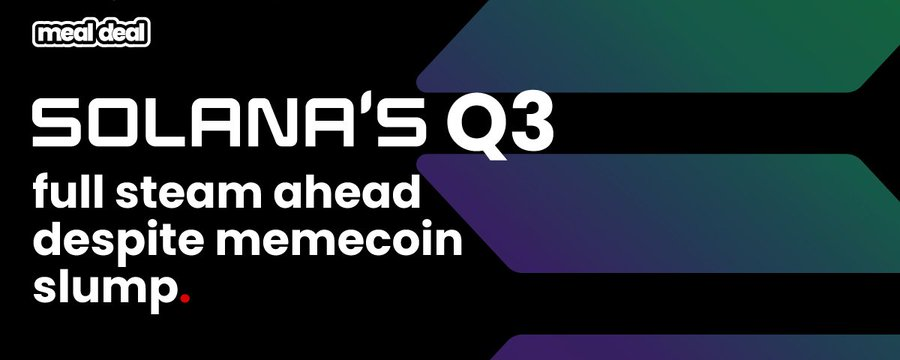
In the third quarter of 2025, it is a "two-sided story on the same chain" for Solana. On the surface, the "Meme retreat" has brought a noticeable cooling effect: daily active addresses have declined, and the user dominance is gradually being eroded by competitors. However, beneath the surface, the fundamentals of this chain are becoming increasingly solid. The Solana core team has consistently maintained high-frequency iterations, continuously advancing one of the most ambitious technology roadmaps in the crypto industry; meanwhile, its TVL grew by over 26% in the third quarter, and the supply of stablecoins has nearly tripled since the beginning of the year.
This report will systematically outline the core technological upgrades that are defining Solana's future (such as Alpenglow and Agave), deeply analyze on-chain data performance, the health of ecological applications, and summarize our key insights on how Solana can consolidate its position as the "default high-performance public chain."

Multifaceted Technological Innovations
While most users on the platform are busy chasing the latest meme expressions, the @solana core team has been advancing a highly ambitious system-level upgrade roadmap. This is not just a patchwork of single metrics, but a comprehensive engineering effort to enhance network performance, security, decentralization, and user experience. These upgrades can be broadly categorized into three main types.
First Category: Core Engine (Consensus and Client)
This is a fundamental overhaul of Solana's "engine," aimed at improving performance, speed, and security from the most basic level. There is a great visualization chart that you can check out if you're curious about the current staking ecosystem.
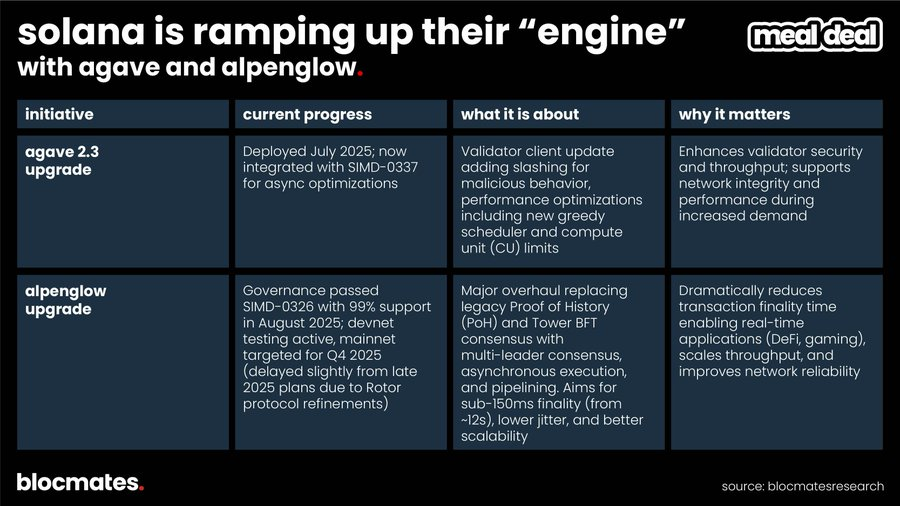
Second Category: Network Highway (Throughput and Efficiency)
The focus of this part is to widen the network "lanes" after enhancing the underlying performance, optimizing traffic scheduling to handle higher future loads without congestion. If institutional users truly want to go on-chain in the future, low latency and stable experience are fundamental, not optional.
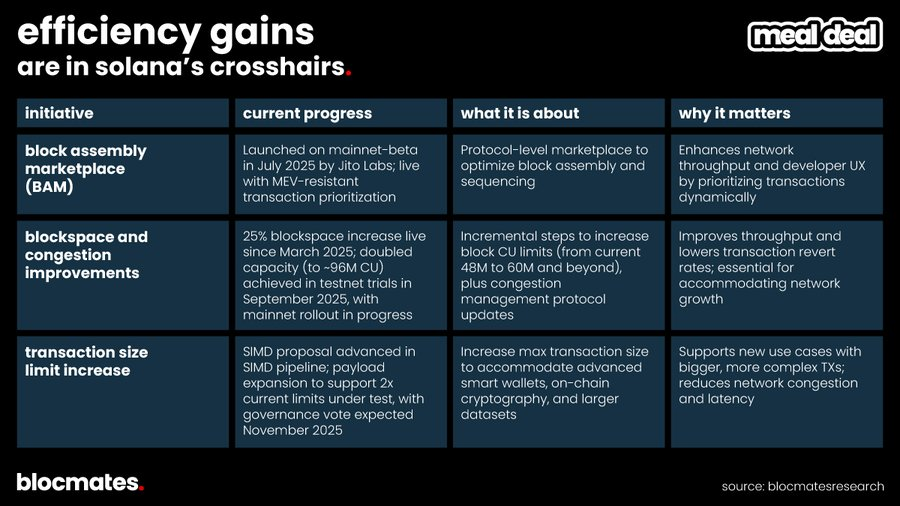
Third Category: Destination (New Capabilities for Ecology and Application Layer)
This category of upgrades is aimed directly at developers and end users, intending to provide more new features, support new types of application forms, and further enhance the chain's level of decentralization. In other words, this is a module that allows the "chain to do more things."
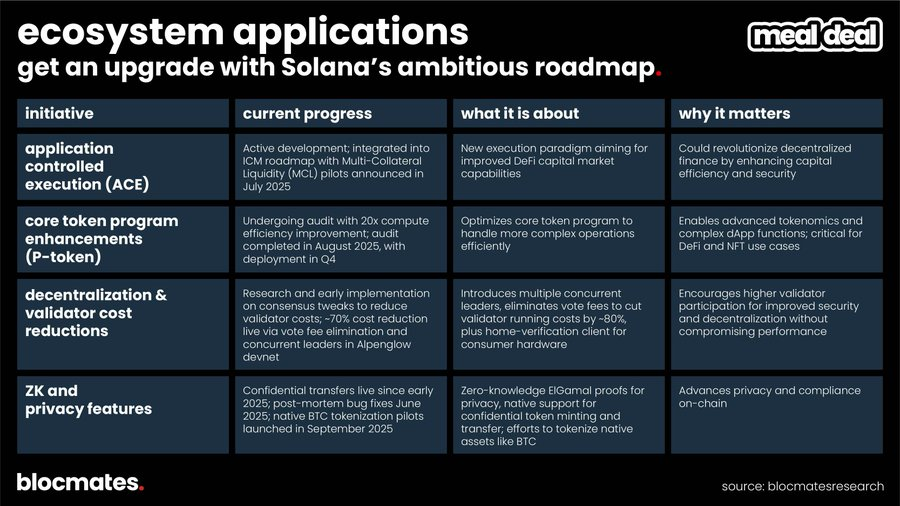
Practical Impact of Technological Improvements
From a practical usage perspective:
- Alpenglow: Final confirmation speed below 150ms allows retail users to use high-frequency DeFi, gaming, or micropayment applications on-chain, with performance approaching Binance's 100ms and Aptos's 200ms levels.
- Firedancer: Potential capacity exceeding 1 million TPS far surpasses Ethereum and its L2s (such as OP's approximately 2k TPS), Sui's 300k TPS, and centralized exchanges (Coinbase peak around 500k TPS). It also significantly reduces the systemic risk of single client failures (Ethereum's Geth still accounts for 60% of nodes).
- Block space improvements, congestion relief, and transaction size limit optimization: Enhances the overall experience of using the chain, enabling finer-grained micropayments, ICOs (like $PUMP), and rapid transactions while reducing failures due to congestion.
- Decentralization and reduced node costs: Allows users with lower technical thresholds to run nodes, thereby enhancing the overall security and decentralization of the network.
- ZK and privacy support: Provides a compliant, private, and secure foundation for the entry of RWA and institutional users.
- BAM (Fair Trading, Anti-MEV): Ensures transaction fairness and protects users from MEV losses, making the on-chain experience closer to a predictable low-cost environment of CLOB.
- ACE (Multi-Collateral Liquidity): Further promotes the deepening of DeFi capital markets, enabling competition with platforms like Aave and supporting more complex financial instruments.
PUMP ICO: Validation of On-Chain Stress Testing
In July 2025, the ICO of Pump.fun became a real "stress test" for Solana's performance. @pumpfun raised $500 million and $100 million through on-chain and centralized exchanges, respectively, in just 12 minutes, corresponding to a valuation of up to $4 billion. During this period, 3,878 investors transparently completed subscriptions on Solana's Raydium, Jupiter, and other DEXs, while some CEXs (like Bybit) experienced delays due to multiple API failures, causing about 2,500 confirmed investors to miss timely orders due to API delays and be forced to refund.
Does this mean we are witnessing a possible future—where the performance of decentralized blockchains begins to surpass that of centralized exchanges?
So where does Solana currently stand? The Truth Revealed by Data
From the data perspective, as traders shift from meme speculation to perpetual contracts, Solana's on-chain revenue metrics have shown a significant impact: on-chain fees as a percentage of SOL's market value have declined by over 60% since the peak in July.
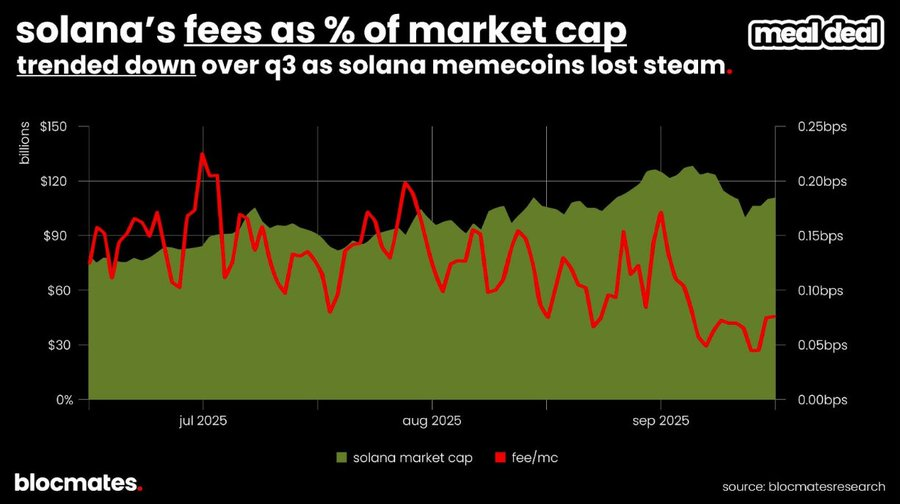
Meanwhile, despite ongoing discussions about stablecoins on Capitol Hill and Wall Street, the leaders remain Ethereum and Tron, with Solana alongside Base, BSC, and Arbitrum in the "second tier."
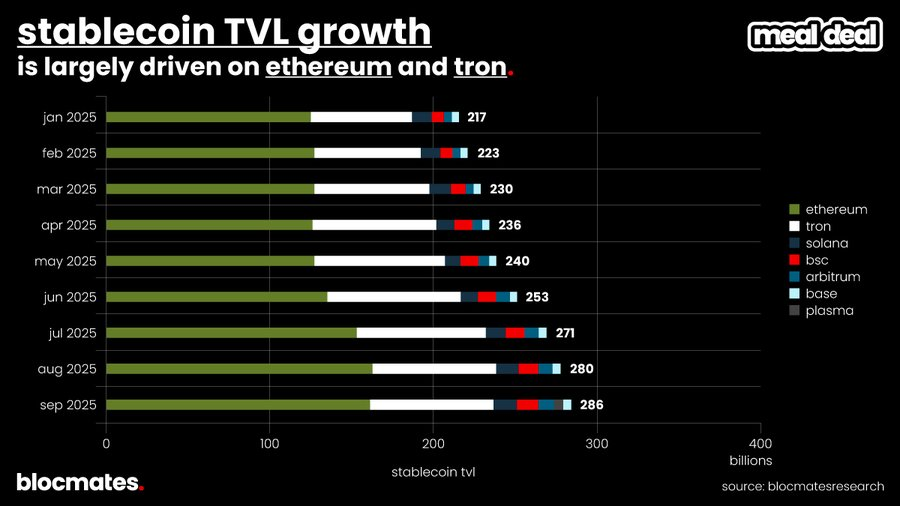
Further breaking down the stablecoin TVL share reveals that Ethereum and Tron have almost consistently dominated over the past few quarters, while some emerging application chains—such as @Plasma—are gradually squeezing into this landscape.

Nevertheless, Solana still provides a fast, low-cost, and liquid USDC usage environment, which may be why Western Union chose to build its stablecoin business on Solana.
"Experimental" will become one of the core themes of this report, and this spirit is also reflected in the stablecoin ecosystem: new projects are gradually eroding USDC's dominance, bringing more competition to Solana's stablecoin landscape.

Which Ecological Participants are Driving Chain Growth?
From the perspective of TVL growth rate, staking products are the absolute highlight of Solana applications in the third quarter, with staking SOL provided by Binance and Bybit, as well as products from @Sanctumso, all recording over 50% growth in the third quarter. 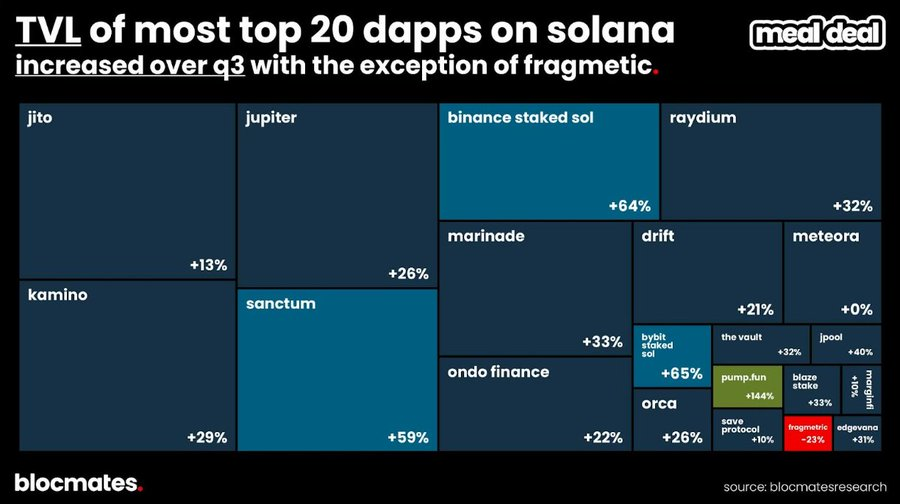
In contrast, while DEX, DeFi, and infrastructure products also saw an increase in TVL, they failed to surpass SOL's own 28% increase—indicating that in SOL terms, these categories actually experienced net outflows in the past quarter.
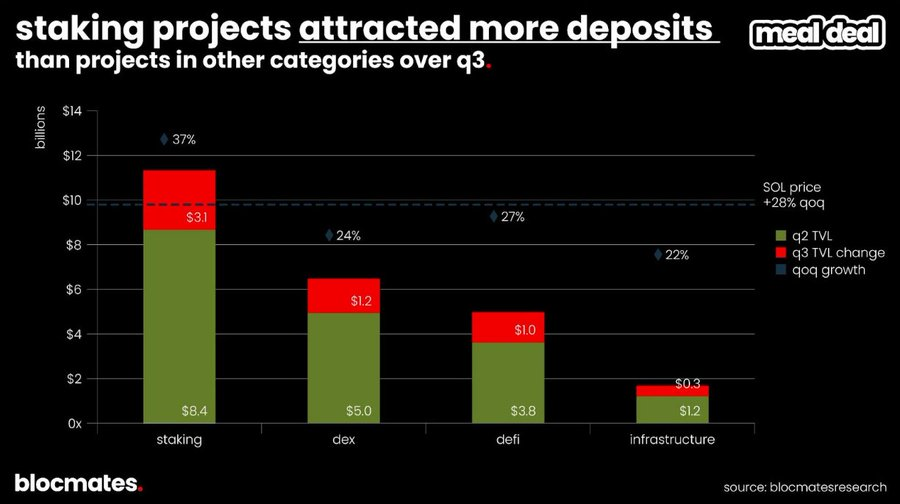
The shortcoming of staking products is their weak profitability: on average, a staking protocol requires 21.7 times the TVL to reach the average revenue level of DEX in this sample. This again highlights a fact—the profits contributed by speculators far exceed those of savers.
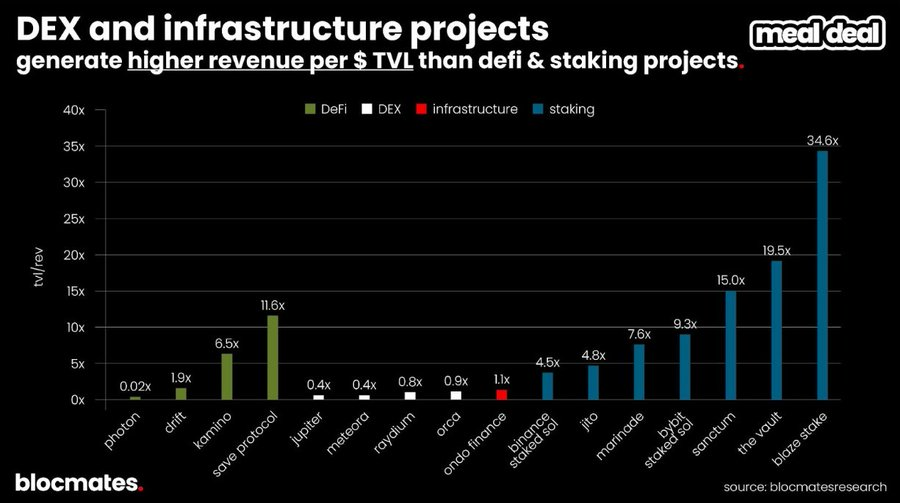
In the DEX track, @Orca_so has consistently maintained a leading position in TVL efficiency (i.e., "trading speed"). Given the liquidity scale, the trading frequency per dollar on Orca is the highest.
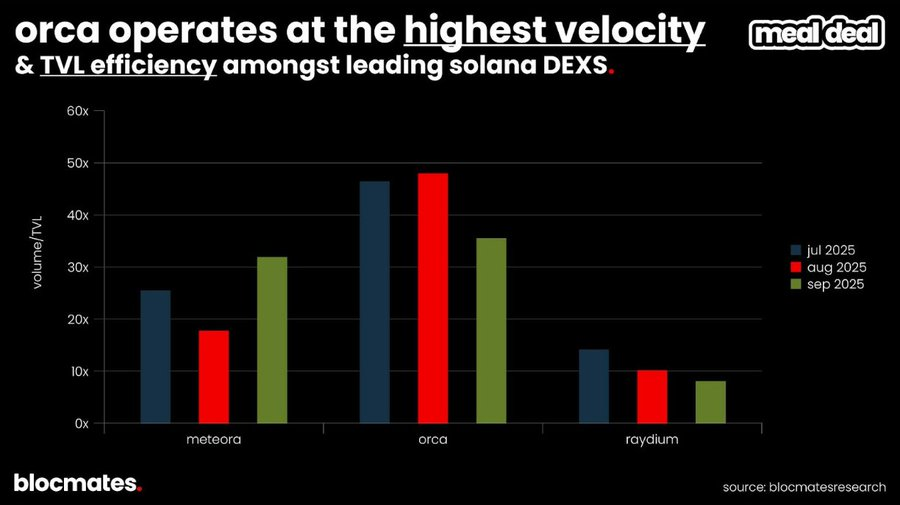
While Solana has always been known for being "fast and cheap," this does not mean there are no exceptions. For example, some high-frequency deep users on trading platforms like @tradewithPhoton or @AxiomExchange have daily average fee expenditures that far exceed expectations.
However, for the vast majority of users, using the most common applications on Solana only costs a few cents a day.

Horizontal Comparison of Solana and Core Competitors
The total TVL across the chain at the end of the third quarter was slightly below the historical high of nearly $180 billion in 2021, but when comparing various competing public chains, it can be observed that the quarterly changes in TVL among them are actually quite limited.

The market share chart below clearly shows how the TVL of these competitors fluctuates weekly in sync. As Newton said, "Idle capital tends to remain idle," and once capital is settled, it is often difficult to migrate on a large scale.
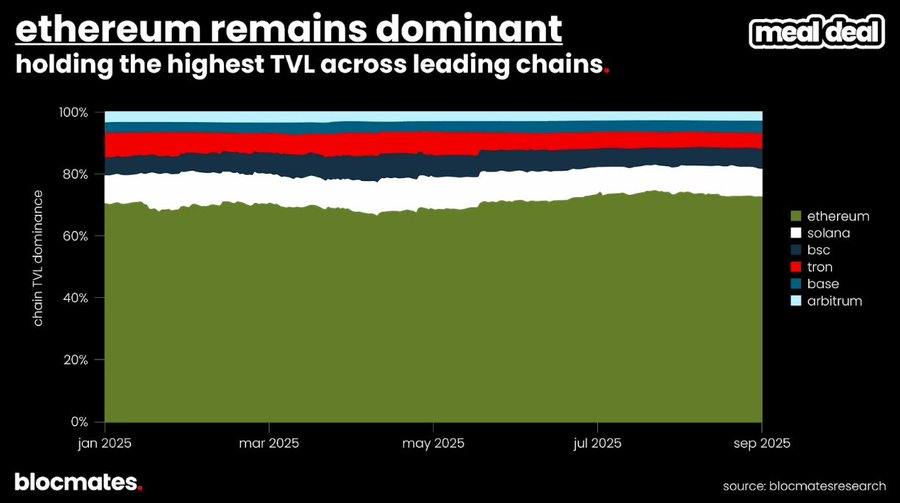
In terms of user scale, Binance Smart Chain captured the most attention in the third quarter with its perpetual DEX—Aster—associated with CZ. A large number of users either chose to exit in early summer or migrated from Base and Solana to BSC.
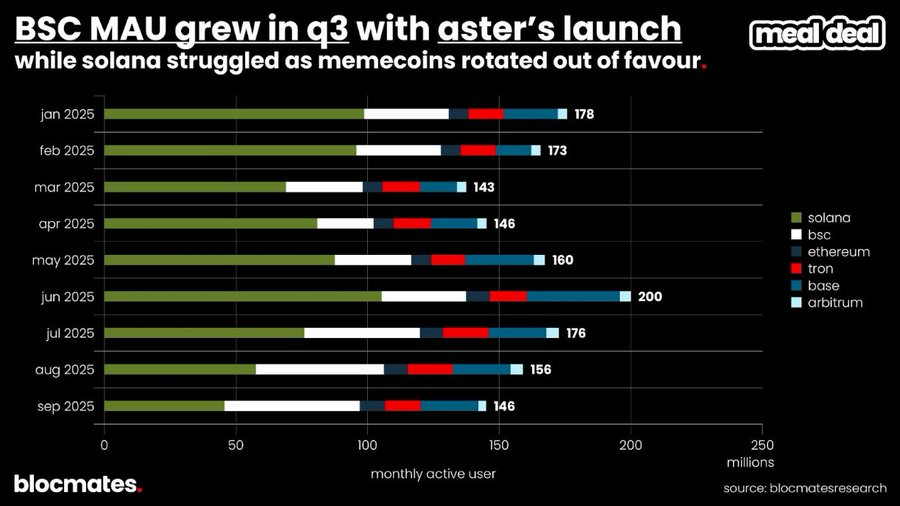
Although Solana experienced a noticeable user growth in the second quarter, its share also receded in the third quarter, which almost coincided with the market's declining interest in meme trading.

However, it is worth noting that due to the surge in attention to stablecoins, Solana's stablecoin supply has nearly tripled from the beginning of the year to the end of the third quarter. It has been proven that "fast and cheap" is a major selling point for attracting users to use stablecoins, especially in the context of Solana's already mature DeFi ecosystem.
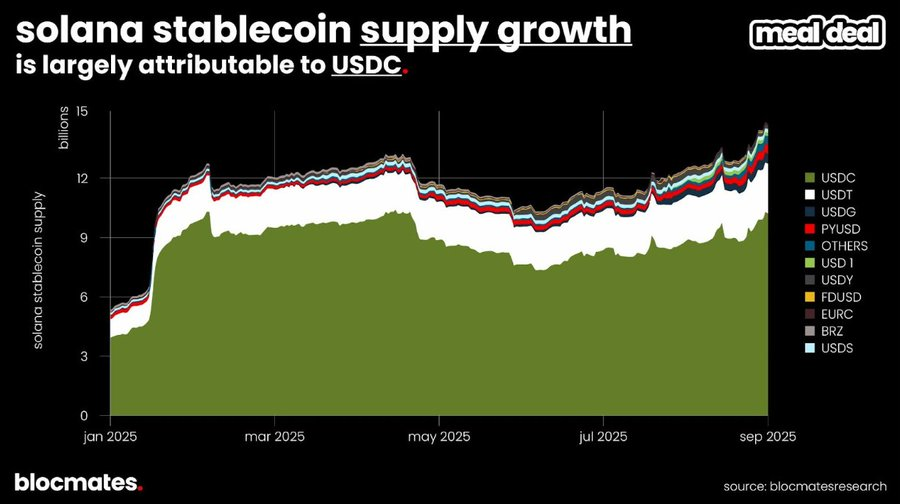
Although these metrics depict the current landscape, they do not reflect the future direction. Solana's identity has always been that of an "experimental chain." To understand future use cases and narratives, we must observe where the funds are flowing towards new experiments.
VC Funding Trends: Which Projects Are Securing Financing?
Here are some Solana projects that secured notable institutional investments in the third quarter:
- @raikucom: Completed a $13.5 million seed round in September 2025, focusing on real-time liquidity scheduling and cross-chain bridging as a DeFi infrastructure on Solana, primarily serving high-frequency trading applications, supporting sub-second settlements while avoiding MEV risks. This round was led by @PanteraCapital, and the funds will be used for mainnet upgrades and further integration with DEXs (such as @JupiterExchange).
- @bulktrade: Completed a $5 million seed round in August 2025, a perpetual DEX aimed at institutional users, featuring zero gas batch execution with single transactions up to $10 million. This round was led by @robotventures and @6thManVentures, with Solana co-founder @aeyakovenko participating as an angel investor. Its alphanet testnet launched in the third quarter.
- @meleemarkets: Completed a $3.5 million pre-seed financing in July 2025, a gamified prediction market protocol combining DeFi and social prediction, allowing users to earn yield-bearing tokens through accurate predictions. This round was led by @variantfund and @dba_crypto, with funds allocated for oracle integration and mobile launch. The project secured second place in the Solana Breakout Hackathon.
- @hylo_so: Completed a $1.5 million seed round in September 2025, a decentralized stablecoin protocol on Solana that supports issuing yield-bearing stablecoins (like sUSD) through over-collateralization and automatic rebalancing mechanisms. This round was led by @robotventures, with participation from @SolanaVentures. Funds will be used for mainnet launch and integration with lending platforms like @Kamino.
Where Are the Opportunities and Risks?
Solana exhibited a state of "breakthrough and burden coexistence" in the third quarter. On one hand, innovative applications are continuously approaching product-market fit, and Digital Asset Treasury (DAT) companies are shining; on the other hand, the entire ecosystem must also face some tricky issues.
Projects That Stood Out in Q3
Among the numerous dApps that emerged this quarter, the following launched projects were particularly noteworthy:
- @Titan_Exchange is a new DEX aggregator launched in the third quarter, utilizing improved algorithms to extract depth from different liquidity pools with machine-level precision to obtain the best quotes, outperforming existing competitors in 80% of cases.
- @DefiTuna is a new DeFi AMM launched in the third quarter, integrating a true on-chain limit order mechanism directly into the AMM design, avoiding security risks associated with off-chain matching while allowing LPs to use up to 5x leverage for liquidity position allocation (leveraged yield).
- @xStocksFi tokenizes stocks held by licensed brokers, enabling crypto users to easily access the economic rights of their underlying stocks; it launched in early third quarter with a quarterly trading volume exceeding $800 million, capturing about 60% market share.
- Pump.fun (streaming + mobile) initiated a token buyback in the third quarter after facing significant selling pressure and relaunched its live streaming feature, with a cumulative buyback scale reaching $100 million by the end of the quarter.
- @MetaDAOProject made headlines due to large-scale oversubscription projects, including Umbra. Projects launched through MetaDAO (refer to our report) bind legal, economic, and governance rights in their tokens, referred to as "ownership coins." Additionally, governance proposals are not decided by voting but are priced through trading in "futarchic markets," allowing participants to express their views with real money.
DAT Development Status
In the third quarter, Solana's DAT raised approximately $4.25 billion through private placements, PIPE, and equity offerings, with Forward Industries (FORD) being the largest. About $3.5 billion was used to purchase 14.5 million SOL, accounting for 2.3% of SOL's circulating supply.
Despite this, Solana's DAT still struggles to escape the mNAV contraction pressure that has generally appeared in the crypto DAT ecosystem in the third quarter.
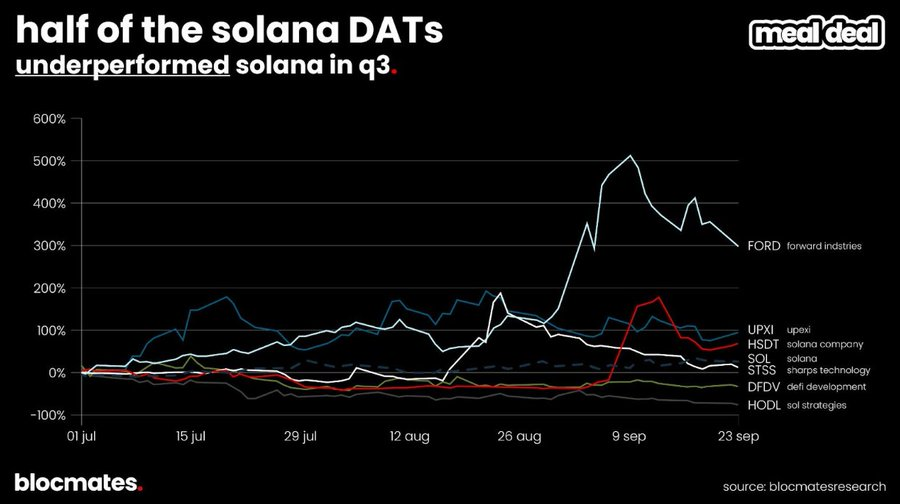
Addressing Common Criticisms
Like almost all crypto projects, Solana is in a continuous evolution phase and is far from perfect. From our perspective, the following criticisms are more of the growing pains in the process, but they are still worth paying attention to.
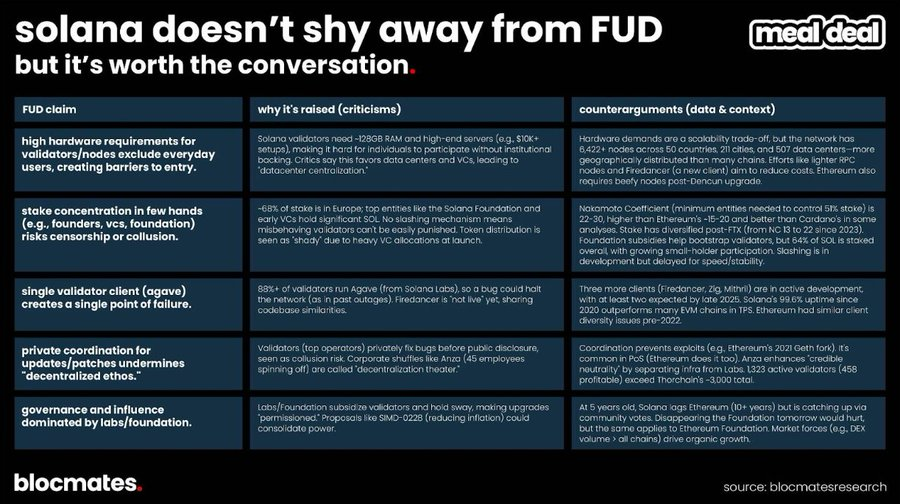
The Biggest Risk: Brand Narrative
Solana has long been labeled as "the best place for experimentation." Trading bots, ICM, consumer applications, AI agents—where did these innovations first appear? Solana.
However, during this cycle, attention has become increasingly scarce, and projects that can find product-market fit seem to be concentrated in a few niches and very few applications. This stagnation has given competitors the opportunity to seize the narrative:
- Perpetual contracts have migrated from applications on general chains to application-specific chains like Hyperliquid;
- Base has deeply bet on the consumer application narrative with the Base app and Zora, an area that was once Solana's stronghold;
- Stablecoin chains like Tempo, Plasma, Stable, and Arc continue to threaten the dominance of Ethereum and Tron in the stablecoin space.
This leads to the core risk: yes, Pump is a revenue machine and has indeed withstood competition from "external" (Base/BSC) and "internal" (BonkFun) sources, but the side effect of this success could permanently lock Solana's brand as a "casino chain."
To reverse this trend, Solana must promote a new narrative. Perhaps the answer still lies with Pump, but through its live streaming platform; it could also be the "non-runnable ICO" and new governance structure proposed by MetaDAO; or it might be Toly's experimental proposal targeting Hyperliquid with a personal touch. The ecosystem needs a new story that can dilute the stigma brought by "sub-second retail traders."
Our Judgment on Solana's Prospects
Although the market appears slightly sluggish after the end of the meme season, the significance of short-term price fluctuations is diminishing. Solana has established a solid position and is determined to exist long-term.
Newly launched high-performance public chains (such as Sui, Aptos, Sei) do not pose a substantial threat to Solana as it did in the previous cycle when Solana challenged Ethereum. Even if some competitors are theoretically more technically advanced, Solana is already "fast enough, cheap enough," with a user experience that is sufficiently good and supports a large ecosystem.
Technical capability and smooth experience are the foundations of adoption. Solana is not just maintaining its lead but is continuously iterating rapidly (as detailed in the upgrade section earlier in this report) to stabilize its position and expand its capabilities. For these reasons, developers still regard Solana as the preferred choice for high performance, and we believe this trend will not reverse.
Solana embodies the spirit of "daring to try and compete, open competition, and extreme marketization" in the crypto space, making it the best arena for validating product-market fit. Regardless of where this cycle leads, Solana has the conditions to survive and continue to thrive. Even if some trading volume flows to application-specific chains, we still believe Solana will maintain its leading position in the general chain space.
免责声明:本文章仅代表作者个人观点,不代表本平台的立场和观点。本文章仅供信息分享,不构成对任何人的任何投资建议。用户与作者之间的任何争议,与本平台无关。如网页中刊载的文章或图片涉及侵权,请提供相关的权利证明和身份证明发送邮件到support@aicoin.com,本平台相关工作人员将会进行核查。



